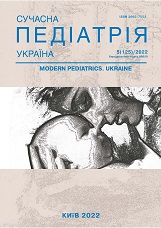Interstitial lung disease and neurodegeneration in FINCA syndrome: new knowledge changes old judgments
DOI:
https://doi.org/10.15574/SP.2022.125.103Keywords:
FINCA syndrome, interstitial lung disease, neurodegenerative disorders, hemolytic anemia, episodic diarrheaAbstract
FINCA (Fibrosis, Neurodegeneration, Cerebral Angiomatosis) syndrome is a new genetic multiorgan disease caused by a mutation in NHLRC2 (NHL repeat-containing protein 2). Disease manifests at an early age by interstitial lung disease, neurodegenerative disorders, hemolytic anemia, gastrointestinal disorders, liver dysfunction and other multiorgan changes. The syndrome was first described in 2018 in three children who died before the age of two. Studies in recent years have significantly expanded the range of clinical symptoms of FINCA syndrome, and also showed great variability in the severity of the symptomes, especially respiratory lesions. Taking into account the neurological problems in all described patients, NHLRC2 should be included in the sequencing panels of neurological diseases (neurodegenerative, neurodevelopmental disorders, epilepsy). Recurrent respiratory infections and episodic diarrhea, as well as hypogammaglobulinemia in most patients require study of the role of NHLRC2 protein in the functioning of the immune system.
No conflict of interests was declared by the authors.
References
Badura-Stronka M, Śmigiel R, Rutkowska K et al. (2022). FINCA syndrome-Defining neurobehavioral phenotype in survivors into late childhood. Mol Genet Genomic Med. 10 (4): e1899. https://doi.org/10.1002/mgg3.1899; PMid:35255187 PMCid:PMC9000936
Biterova E, Ignatyev A, Uusimaa J, Hinttala R, Ruddock LW. (2018). Structural analysis of human NHLRC2, mutations of which are associated with FINCA disease. PLoS One. 13 (8): e0202391. https://doi.org/10.1371/journal.pone.0202391; PMid:30138417 PMCid:PMC6107167
Boyarchuk O, Dmytrash L. (2019). Clinical Manifestations in the Patients with Primary Immunodeficiencies: Data from One Regional Center. Turkish Journal of Immunology. 7 (3): 113-119. https://doi.org/10.25002/tji.2019.1168
Boyarchuk O, Kinash M, Hariyan T, Bakalyuk T. (2019). Evaluation of knowledge about primary immunodeficiencies among postgraduate medical students. Archives of the Balkan Medical Union. 54 (1): 11-19. https://doi.org/10.31688/ABMU.2019.54.1.18
Boyarchuk O, Lewandowicz-Uszyńska A, Kinash M, Haliyash N, Sahal I, Kovalchuk T. (2018). Physicians' awareness concerning primary immunodeficiencies in the Ternopil Region of Ukraine. Pediatria Polska. 93 (3): 221-228. https://doi.org/10.5114/polp.2018.77435
Brodsky NN, Boyarchuk O, Kovalchuk T et al. (2020). Novel compound heterozygous variants in NHLRC2 in a patient with FINCA syndrome. J Hum Genet. 65 (10): 911-915. https://doi.org/10.1038/s10038-020-0776-0; PMid:32435055
Bush A, Cunningham S, de Blic J et al. (2015). European protocols for the diagnosis and initial treatment of interstitial lung disease in children. Thorax. 70 (11): 1078-1084. https://doi.org/10.1136/thoraxjnl-2015-207349; PMid:26135832
Distler O, Highland KB, Gahlemann M et al. (2019). Nintedanib for Systemic Sclerosis-Associated Interstitial Lung Disease. N Engl J Med. 380 (26): 2518-2528. https://doi.org/10.1056/NEJMoa1903076; PMid:31112379
Flaherty KR, Wells AU, Cottin V et al. (2019). Nintedanib in Progressive Fibrosing Interstitial Lung Diseases. N Engl J Med. 381 (18): 1718-1727. https://doi.org/10.1056/NEJMoa1908681; PMid:31566307
Hiltunen AE, Kangas SM, Ohlmeier S et al. (2020). Variant in NHLRC2 leads to increased hnRNP C2 in developing neurons and the hippocampus of a mouse model of FINCA disease. Mol Med. 26 (1): 123. https://doi.org/10.1186/s10020-020-00245-4; PMid:33297935 PMCid:PMC7724728
Horvath B, Kloesel B. (2022). FINCA syndrome, a novel interstitial lung and multiorgan disease. Paediatr Anaesth. https://doi.org/10.1111/pan.14475; PMid:35557017
Maher TM, Corte TJ, Fischer A et al. (2020). Pirfenidone in patients with unclassifiable progressive fibrosing interstitial lung disease: a double-blind, randomised, placebo-controlled, phase 2 trial. Lancet Respir Med. 8 (2): 147-157. https://doi.org/10.1016/S2213-2600(19)30341-8
Marunchyn TA, Volokha AP. (2019). Management of children with primary and secondary hypogammaglobulinemia (literature review). Modern Pediatrics.Ukraine. 5(101): 123132. https://doi.org/10.15574/SP.2019.101.123
Nishi K, Iwaihara Y, Tsunoda T et al. (2017). ROS-induced cleavage of NHLRC2 by caspase-8 leads to apoptotic cell death in the HCT116 human colon cancer cell line. Cell Death & Disease. 8: 3218. https://doi.org/10.1038/s41419-017-0006-7; PMid:29242562 PMCid:PMC5870588
Paakkola T, Salokas K, Miinalainen I et al. (2018). Biallelic mutations in human NHLRC2 enhance myofibroblast differentiation in FINCA disease. Hum Mol Genet. 27 (24): 4288-4302. https://doi.org/10.1093/hmg/ddy298; PMid:30239752
Rapp CK, Van Dijck I, Laugwitz L et al. (2021). Expanding the phenotypic spectrum of FINCA (fibrosis, neurodegeneration, and cerebral angiomatosis) syndrome beyond infancy. Clin Genet. 100 (4): 453-461. https://doi.org/10.1111/cge.14016; PMid:34165204
Thalhammer J, Kindle G, Nieters A et al. (2021). European Society for Immunodeficiencies Registry Working Party. Initial presenting manifestations in 16,486 patients with inborn errors of immunity include infections and noninfectious manifestations. J Allergy Clin Immunol. 148 (5): 1332-1341.e5. https://doi.org/10.1016/j.jaci.2021.04.015; PMid:33895260
Uusimaa J, Kaarteenaho R, Paakkola T et al. (2018). NHLRC2 variants identified in patients with fibrosis, neurodegeneration, and cerebral angiomatosis (FINCA): characterisation of a novel cerebropulmonary disease. Acta Neuropathol. 135 (5): 727-742. https://doi.org/10.1007/s00401-018-1817-z; PMid:29423877
Downloads
Published
Issue
Section
License
Copyright (c) 2022 Modern pediatrics. Ukraine

This work is licensed under a Creative Commons Attribution-NonCommercial 4.0 International License.
The policy of the Journal “MODERN PEDIATRICS. UKRAINE” is compatible with the vast majority of funders' of open access and self-archiving policies. The journal provides immediate open access route being convinced that everyone – not only scientists - can benefit from research results, and publishes articles exclusively under open access distribution, with a Creative Commons Attribution-Noncommercial 4.0 international license (СС BY-NC).
Authors transfer the copyright to the Journal “MODERN PEDIATRICS. UKRAINE” when the manuscript is accepted for publication. Authors declare that this manuscript has not been published nor is under simultaneous consideration for publication elsewhere. After publication, the articles become freely available on-line to the public.
Readers have the right to use, distribute, and reproduce articles in any medium, provided the articles and the journal are properly cited.
The use of published materials for commercial purposes is strongly prohibited.

